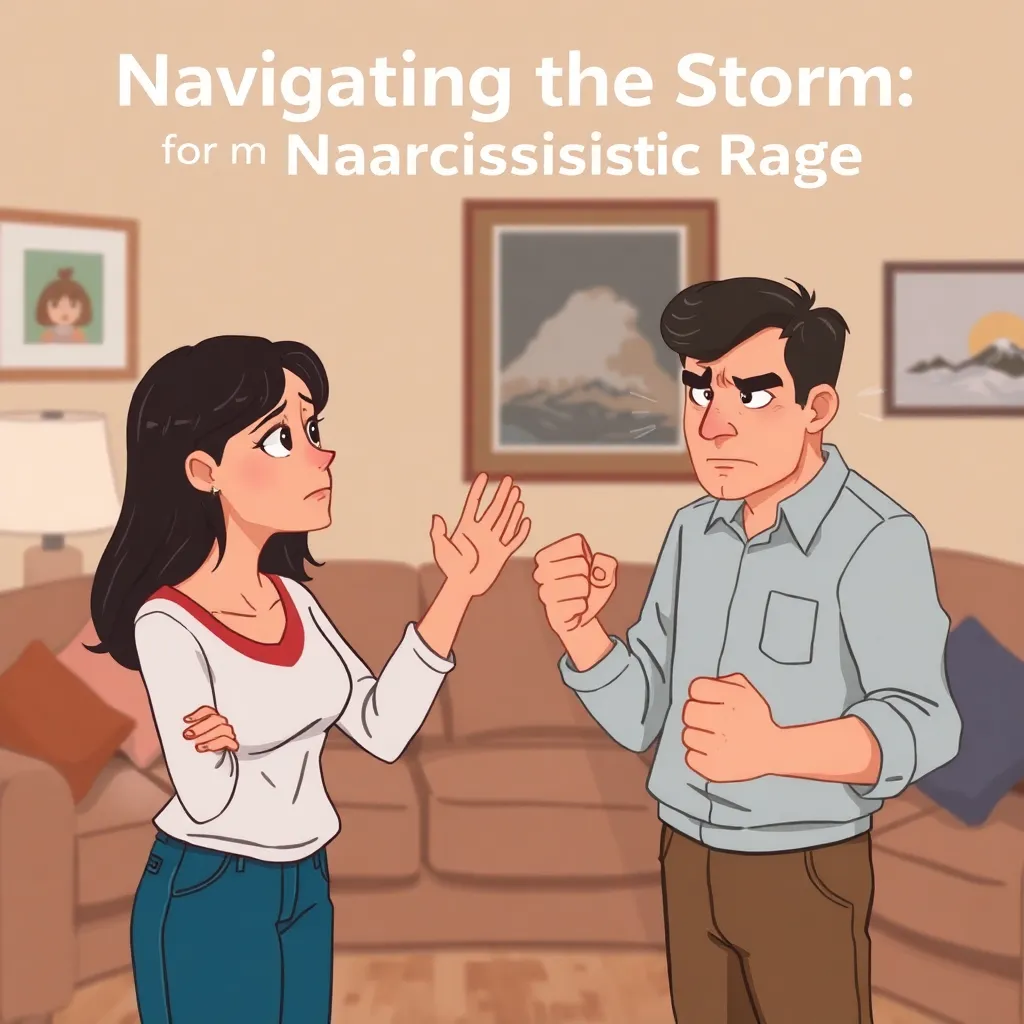Navigating a relationship with a person who exhibits narcissistic rage can feel like walking on a tightrope, where minor missteps might provoke an unexpected storm. It’s a challenging path that often leaves you questioning your actions and seeking a peaceful way forward. Understanding when and how to respond to such intense emotions is not just crucial for maintaining your own emotional well-being, but also for managing the dynamics of the relationship effectively. This article aims to guide you through these turbulent waters with compassion and insight, providing you with the tools to make informed decisions.
Recognizing the signs of narcissistic rage is the first step toward knowing when to engage or step back. Often, these outbursts can be bewildering and intense, leaving you feeling overwhelmed and unsure of the best course of action. Here, you’ll find not only recognition of your struggles but also practical advice on how to handle these situations with empathy and strength. Our goal is to empower you with the knowledge to protect your emotional health while navigating the complexities of a relationship with a narcissistic individual.
You’ll learn how to differentiate between moments that require immediate response and those where silence might be the more prudent choice. By understanding these nuances, you can maintain your dignity and peace of mind, even in the face of challenging interactions. This journey of learning is about more than just survival; it’s about thriving in the midst of adversity and reclaiming your own narrative. With this article, you are taking a courageous step towards a more harmonious and fulfilling relationship with both yourself and others.
1. Recognizing Narcissistic Rage Triggers

Understanding the triggers for narcissistic rage is essential for managing such situations effectively. Narcissistic rage often erupts when a narcissist feels their self-image is threatened, such as when they face criticism or rejection.
Consider a scenario where a partner’s innocent suggestion for improvement spirals into an argument. This could be because the narcissist perceives the suggestion as a threat to their perceived superiority.
Experts suggest that recognizing these triggers early can help in de-escalating potential conflicts. By observing patterns in behavior, like sudden anger following a specific event, you can better understand the root causes of the rage.
One effective approach is to calmly acknowledge the narcissist’s feelings without feeding into their emotional outburst. This tactic can help defuse tension and allow for a more constructive conversation later.
By identifying the triggers of narcissistic rage, you can strategically choose when and how to respond. This knowledge empowers you to protect your emotional well-being while also potentially improving the relationship dynamic.
2. Assessing Safety Before Engagement

Before deciding to engage, it’s crucial to assess your safety in the situation. In a heated moment, take a step back to evaluate whether the environment is physically and emotionally safe for you to respond.
Consider experiences in past interactions where you’ve felt threatened or uncomfortable. If a partner’s anger has ever escalated to verbal or physical aggression, it’s important to prioritize your well-being above all else.
Engaging with someone in a state of narcissistic rage can be unpredictable. It’s helpful to remember that not every moment is the right moment for a confrontation, and sometimes the best choice is to wait for a calmer time to discuss the issue.
Ultimately, the goal is to maintain your own peace and security. By thoughtfully assessing safety first, you empower yourself to respond in a way that is both mindful and protective of your own needs.
3. Timing Your Response Effectively

Understanding the right moment to respond to narcissistic rage is crucial for maintaining a sense of control. When emotions run high, it’s often best to take a step back and allow the intensity to subside before engaging. This approach not only protects your emotional well-being but also lays the groundwork for a more constructive conversation.
Consider the dynamics of a couple where one partner frequently experiences intense emotional outbursts. By observing the pattern of these episodes, you can identify calmer moments that are more conducive to dialogue. Timing your response allows you to communicate more effectively and reduces the chances of exacerbating the situation.
Reflecting on expert insights, it’s clear that responding immediately to narcissistic rage can often escalate the tension. Allowing some time to pass lets both partners regain composure, which is essential for a meaningful exchange. This strategy aligns with the advice of many relationship experts who advocate for patience and strategic timing in high-stakes interactions.
In practice, you might find it helpful to set a mental timer, giving yourself a specific period to cool down before responding. This period could range from a few minutes to a couple of hours, depending on the situation’s intensity. Such a conscious delay can lead to more thoughtful responses and a healthier relationship dynamic.
Ultimately, the goal is to foster a space where both partners feel heard and respected. By timing your response effectively, you’re not only protecting yourself but also paving the way for a more harmonious relationship. This thoughtful approach ensures that communication is both impactful and empathetic, transforming challenges into opportunities for connection.
4. Strategies for De-escalating Conflict

In moments of conflict with a narcissistic partner, it’s crucial to focus on maintaining your own sense of calm and composure. By doing so, you not only protect your emotional well-being but also create a space where the conflict can potentially be de-escalated.
One effective strategy is to set clear boundaries during heated exchanges. For example, you might say, “I need to step away for a moment, and we can continue this conversation when we’re both calmer.”
Experts suggest employing a method called the “broken record” technique, which involves calmly repeating your boundaries or key points without getting drawn into the emotional storm. This approach can prevent further escalation and reinforce your stance that you deserve to be treated with respect and dignity.
Visualize a real-world scenario where someone calmly acknowledges their partner’s feelings but insists on discussing the issue later, once emotions have settled. This not only demonstrates empathy but also places importance on resolving conflicts constructively.
Concluding on a practical note, always aim to validate emotions without agreeing to unreasonable demands. By acknowledging feelings without escalating the argument, you’re more likely to guide the interaction towards a peaceful resolution.
5. Maintaining Boundaries Post-Encounter

After successfully de-escalating a conflict with a narcissist, it is crucial to focus on maintaining your boundaries. This involves reinforcing the limits you have established to protect your emotional well-being. Remember, consistency is key in ensuring that these boundaries are respected over time.
Consider the example of Sarah, who regularly deals with her partner’s narcissistic rage. After each encounter, she takes time to reaffirm her boundaries by clearly communicating her expectations. This practice helps prevent future misunderstandings and ensures her needs are not overlooked.
Setting boundaries can be challenging, especially when emotions are high. However, experts suggest that having a clear plan of what you are willing to accept can significantly reduce stress. Communicating these boundaries calmly and assertively paves the way for healthier interactions.
Ultimately, maintaining boundaries is not about controlling the other person’s behavior but about safeguarding your own peace. Consistently applying these boundaries will help you manage future encounters more effectively. This proactive approach ensures that your emotional well-being remains a priority, enabling you to thrive despite the challenges.
Conclusion: Creating Beautiful Outdoor Spaces
In navigating the challenging waters of narcissistic rage, understanding key relationship concepts can be your compass. First, recognizing the signs of narcissistic behavior is crucial to identifying underlying issues. Second, setting firm boundaries helps protect your emotional well-being. Third, communication is vital; approaching conversations with empathy can sometimes de-escalate tensions. Fourth, prioritizing self-care ensures you maintain your mental health amidst turmoil. Lastly, seeking professional help, such as therapy, can provide invaluable support and guidance.
As an actionable step, start by reflecting on your boundaries and identify areas where they may need strengthening. This simple yet powerful action can create immediate positive change in your interactions.
Remember, relationship success is a journey, not a destination, and each step you take brings you closer to a healthier and more fulfilling connection. To support your journey, bookmark this article for future reference—it can serve as a valuable guide whenever you need a reminder or reassurance.
With patience, understanding, and the right tools, you can navigate even the most turbulent relationships, paving the way for growth and harmony. Your path to relationship success begins now, and you’re more equipped than ever to walk it confidently.
